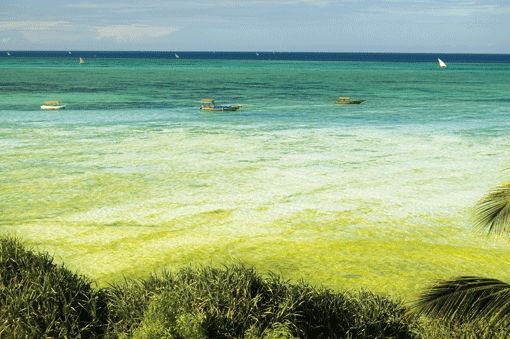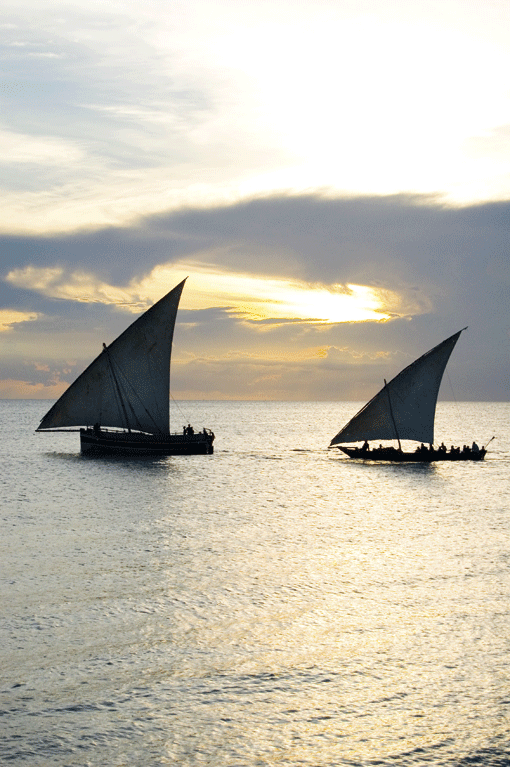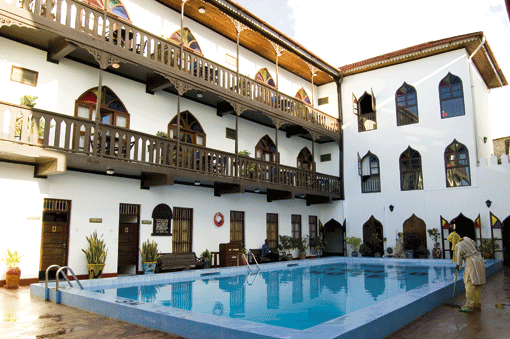
Travel
Zanzibar
An Exotic Archipelago

Zanzibar evokes the exotic, an archipelago of spice islands on the Indian Ocean, a destination that is both legendary and mysterious. These sultry, balmy, easygoing islands are characterized by vast sandy beaches lapped by the proverbial turquoise waters.
By: Veronica Maria Garbutt
Offshore reefs and wrecks offer great locations for snorkelers and scuba divers to view a wide variety of fish, whales, dolphins, eels and coral formations. And you can spend hours wandering the winding streets of Stone Town, a UNESCO World Heritage Site, said to be East Africa’s only functioning ancient city.
A separate state within Tanzania, Zanzibar consists of two large islands, Unguja and Pemba, plus several smaller islands. Unguja is about 85 km long and 20-30 km wide; Pemba is some 75 km long and 15-20 km wide and was named Al Khudra ‘Green Island’ by Arab sailors after the lush fertility they found on their long journey south along the arid coastline. And, delighted by their welcome, the same mariners founded the city at Ras Mkumbuu, possibly the oldest permanent settlement south of Lamu.
Pemba rises from the Indian Ocean on its own granite pedestal, a continental landmass topped with lush green hillscapes that tumble through clove plantations to pristine white beaches. Both islands have rocky inlets with lagoons and mangrove swamps and coral reefs beyond the shoreline. Fishing and farming are the mainstays of the economy and most denizens live in its small villages. Cloves, cinnamon, mace and coconut products are exported while coffee, cassava and corn are grown for local consumption. By far the largest settlement is in Unguja’s west coast.
Zanzibar’s past created a confluence of cultures, its people, a distillation of nations of travelers, fishermen, explorers and merchants, stopped here. A tolerant society was born as a result, and a spirit of ‘nadama’, an indefinable concept ‘of being and humane.’ A people of great hospitality endure there today, evident in the amicable ‘jambo’ or welcome.
The archipelago’s history goes back to the first millennium when Bantu people from mainland Africa crossed the Zanzibar channel. But the islands had been visited earlier by sailors and traders from Arabia, Persia and India and in the 10th century CE, merchants from Shiraz settled in Zanzibar and mingled with its local Swahili people.
Between the 12th and 15th centuries, the archipelago came into its own as trade links between the Arabian Gulf flourished. Zanzibar became a mighty city state supplying gold, ivory, wood and slaves to Asia while importing textiles, glassware and spices. Islam arrived, as did the ornate Arabic architecture which survives till this day. The remains of the Kizimkazi Mosque, an important archaeological site, date back to the 12th century CE.
This golden age was briefly interrupted in the 16th century when the Portuguese established a trading post on the site of Zanzibar Town and took control. Portuguese dominance was soon challenged, first by the British who found the island a convenient rest stop en route to India, then by the Omani navy. In 1840 Oman’s Sultan Said moved his capital from Muscat to Zanzibar. Here, he built his residence overseeing the busy landing site where all ships had to anchor.
There followed a prosperous era for Swahili civilization. The merchants who plied their trade to and fro across the Indian Ocean did so in ‘sewn boats’. The hulls of these vessels were made of planks of coconut wood sewn together with coarse fibre rather than using metal nails. The construction of a dhow was—and still is—a grand event. When the dhow was ready to be launched, an imam presided over the ceremony, reciting verses from the Qu’ran. Today you can still see dhow builders at work at Nungwi.
In 1890, Zanzibar’s status changed, becoming a British Protectorate. Independence came in 1963 and the following year Tanganyika and Zanzibar were united to become Tanzania. Today life goes on as it has done for centuries, the pace being set by the rhythm of the tides and the monsoon winds. According to UNESCO which conferred a World Heritage Site listed status upon Stone Town, “The surviving town is a physical reflection of testimony to this long term interchange of human values within the coastal region of East Africa. It gives an authentic impression of the living Swahili culture and is the best preserved example of its kind.’
So where better start your island exploration than from Stone Town? A number of buildings were marked as the most architecturally important, including the House of Wonders, Old Fort, the Old Dispensary, Jamat Khan and the Malindi Bamnara Mosque. Many have classic features such as ornamental carved entrance doors, painted arches and verandahs embellished with lattice work resting on pillars of iron. In several cases, an open central courtyard and thick walls built of coral and lime help to keep the interior cool.
All this beauty is brought to life by vendors calling out their wares in the expansive fish and fruit markets while elderly men in their white robes and kofia caps chat animatedly over their bao bao board games. Children play football along the streets and on the town beaches while veiled women in their flowing abayas pause to chat. Several tour operators like Sharif Seif (Tel 225 7741 0200) offer half-day tours through Stone Town, including an introduction to the art of drumming.
And where does one stay in Stone Town? A good choice is the elegant Serena hotel of swaying palms around a large outdoor pool with all guest rooms overlooking the sea. My personal favourite is the antique-filled Tembo House hotel built in the 1830s to house the US Embassy. The hotel’s Bahari Restaurant under Indian almond trees is a fine shady spot for dining. Other excellent eating options in the town include the Old Fort Restaurant which does fine grilled seafood accompanied by traditional drum performances plus there is the Al Johari Fusion Restaurant which serves grilled lobster tail and Zanzibari coconut soup with panache.
Heading north to Nungwi where just east of the lighthouse and turtle sanctuary is the attractive Swahili style garden resort of Mnarani Beach Cottages, was built by the lively Omani Zanzibari Nassor Ali. Constructed using native makuti techniques, it is a peaceful, welcoming retreat at Ras Mungwi overlooking a turquoise sea. Pluses here are long walks along the beach at low tide, a good restaurant with exotica such as calamari, prawn and limefish salad with grilled tuna to follow. And lounging on a hammock or swing afterwards...it’s a hard life! And if you are feeling energetic, there is snorkeling gear and a motorized dhow for fishing excursions and cruising.
Over to the east coast, the Kiwengwa Zamani Zanzibar Kempinski resort caters to the luxury end of the market. Set in expansive, frangipani-filled gardens, the resort’s facilities include pools, tennis and basketball courts and a spa. A golf cart will ferry you to the white sandy Beach Club where there are activities such as kayaking, snorkeling, windsurfing and ngalawa (outrigger canoe) sailing. And restaurants such as Cloves with its Arabian-African influenced buffets, and Red Snapper, with its fine seafood dining overlooking the Indian Ocean, will keep even the fussiest foodie happy.
During your stay in Zanzibar be sure to take a spice tour. Along a guided walk through a shamba spice farm you will see, smell and taste many of the fruits, spices and herbs that the island produces. These include coffee, mace, nutmeg, cinnamon, lemongrass, jackfruit and cardamom, and don’t forget to look out for the soap brush. Its berries lather-like soap and the lipstick tree pods produce a brilliant red dye. Chances are that you will sample a Swahili lunch (including many of the spices).
Later you may get to stop by the Kidichi Persian Baths, the slave cave of Mangapwani or Livingstone’s house. Other worthwhile tours include the Jozani Forest to see the Columbus monkey which is unique to the island and Dolphin tours to Tumbatu island where you have a good chance of spotting playful dolphins as well as meeting fishermen, farmers and local families.
The archipelago’s aquamarine waters, especially around Pemba, are just as stunning beneath the surface. World class scuba diving among the fish, fertile reefs, shipwrecks and abundant lagoons might bring the sight of turtles and seasonal pods of whales as they follow monsoon currents. October to March is the best time for diving.
Numerous PADI accredited diver centres operate on the islands and a five-day open water course costs around US$300. Fishing enthusiasts can follow in Hemingway’s footsteps wake in ‘tag and release’ big game fishing using international standard equipment to land billfish or tuna. Or try their luck with the locals in a jahazi, a traditional lateen sailing ship.
Shopping in Zanzibar is a pleasure. Part of the charm is that many of the shops are run by their owners who are always happy to chat. Stone Town offers the historic Gizenga Street lined with craft dealers and small shops while at Forodhani Gardens vendors sell beaded Masai beaded jewellery, spears and other crafts. Carvers tell of visitors who have left the archipelago with local beds and brass chests filled with treasure. Other good buys include batiks, silks, hand woven cotton, ylang ylang soap and henna. And wherever you go, a spontaneous ‘karibu mgeni, mwenyegi apone’ greeting will make you feel at home. Happy trip!